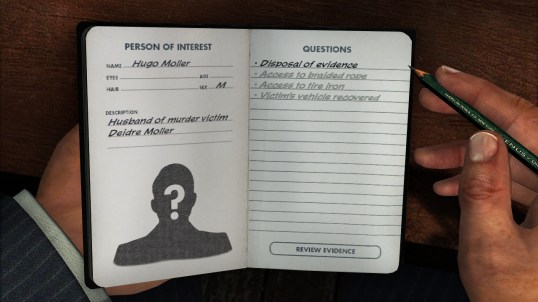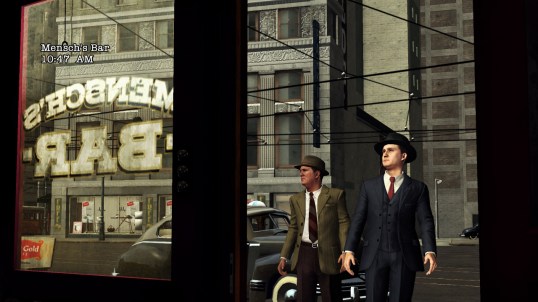Rockstar Games has a reputation. People see the R* icon on a game box and expect chaos of the first degree. The Manhattan-based company’s pushed the boundaries of portraying sex, violence and postmodern attitudes in their best-known series like Grand Theft Auto and Manhunt, letting players turn whole cities into unpredictable petri dishes of mayhem. So, expectations with Rockstar tend to run towards open-world anarchy.
What’s so different, then, about L.A. Noire is how tightly ordered it is. In partnership with Rockstar, Australian development studio Team Bondi has crafted an experience that focuses with laser-like precision on narrative and tone. Last year’s stellar Red Dead Redemption proved Rockstar could quiet things down and still deliver a strong virtual landscape that grabbed hold of you. While there’s still sprinklings of side quests as in previous games, L.A. Noire represents a refinement of the approach begun with Red Dead–tamping down the noise so prevalent in video game worlds–so players can more precisely live through what the game-makers want.
In this case, you’ll inhabit the life of Cole Phelps, a rookie beat cop returned from service as a Marine officer in the Japanese theater of war. Players guide Phelps through the various desks of the L.A.P.D., having him ascend by successfully solving cases. Investigations start at a crime scene where Phelps walks through the environment, picking up and examining clues. Clues lead to questions that you ask of witnesses, suspects or other persons of interest. All that info gets stored in Phelps’ notebook. During these chats, you have to interpret the interviewees’ faces and answers and can choose from Truth, Doubt or Lie to move the Q&A along. The new MotionScan technology used to capture performances delivers more nuance than any other widely available facial animation technique. You have to read faces in L.A. Noire and you’re actually able to distinguish worry from anger or a smirk from a frown. If you get all the answers right in an interview, you earn Intuition points. Intuition’s a sort of superpower that lets you find clues faster at a crime scene or narrow down the possible answers from a suspect. It’s also the most video game-like mechanic in this title. At the end of each episode, you get star ratings based on performance and the case notes offer glimpses of details you might have missed. You can make things harder and more realistic by turning off the gameplay hints and audio cues that ping out when you’re next to a clue.
(More on TIME.com: Rockstar Games’ ‘L.A. Noire’ Goes Full Frontal at Tribeca Film Festival)
Yes, the mechanics of playing are repetitive. Evidence, interview, gunfight/brawl/chase can feel like lather, rinse, repeat. But there’s enough unique texture in each case to keep you engaged. You don’t keep playing to earn high marks; you keep playing to see where the story goes. Testament to that is an option that lets you skip action sequences altogether. You don’t have to shoot it out with thugs in the game, since it’s a foregone conclusion that you’re going to win. You don’t even have to navigate to locations, since you can let your partner drive. The action skip option is a weird choice for a video game whose essence is inherently meant to be played.
However, by letting players opt-out of de rigeur car chases and gunfights, L.A. Noire gives us the chance to dive into something a lot more intriguing. It lets you know what Rockstar and Team Bondi hope to accomplish with L.A. Noire. The priority is to deliver a story and if sneaking around following a suspect proves too hard and gets in the way, then you can move past that and not get penalized. On the other hand, you can never skip an interrogation. That’s the showpiece element in L.A. Noire, and it works well. I found myself having a bit of ego attached to just how well my grilling of suspects went and hated feeling outfoxed by someone who got a lie past me. It’d be a misnomer to call the design architecture of L.A. Noire entirely new. The detective thriller actually gestures backwards in gaming history, riffing on to the text-based adventures and point-and-click games from the medium’s first two decades, but this one adds production values of modern filmmaking and interaction with captured performances.
From the great, gravelly voiceover narration at the beginning of each chapter to the mix of period music and jazzy soundtrack, the new crime thriller also shows off Rockstar’s increasing command of stylistic elements. The writing by Team Bondi’s Brendan McNamara nails the rat-a-tat of tough guy chatter and the visuals feel like an exquisitely designed movie set. You can turn off color for a black-and-white playthrough, too. Narratively, L.A. Noire breaks things up with flashbacks to Phelps’ war days–where we see him trying to become an officer and rivalries with other enlisted men–and lurid parallel plotlines about a Dr. Feelgood-type in the seedy underbelly of postwar L.A.
(More on TIME.com: L.A. Noire Gets L.A. Literary with Official Crime Anthology)
Aside from great presentation, there’s an interesting use of asynchronous social play. If you’re a member of the Rockstar Social Club network, you can access community data by using Intuition. So, if you’re unsure of whether a suspect’s lying, you can see what option other people picked. Mind you, they all could’ve gotten it wrong, too. But it’s an interesting use of hivemind in an essentially solo game. Speaking of solo, it should be noted how Cole Phelps–ably portrayed by Mad Men‘s Aaron Stanton–stands apart as a new kind of Rockstar protagonist. It’s not just that he’s a police detective. It’s also that he’s so ambitious, arrogant and by-the-book as to be a little off-putting. The college-educated cop represents a shift in crime-fighting methodology, away from the bare-knuckle lawmen who’d beat confessions out of people, and towards more methodical procedures. The game built around Phelps is long and episodic in nature, with a subplot that only begins to coalesce in the game’s last third. Nevertheless, for Rockstar, Cole Phelps stands as a watermark of maturity for the developer that was held out only ten years ago as the worst the medium had to offer.
(More on TIME.com: Behold, the Video Game Graphics of the Future! [Updated with Video])
You could dismiss L.A. Noire as a less-than-game, where you spend more time watching things unfold than pressing buttons or making things happen. However, watching is playing in this sometimes grisly detective title. It’s common to look away from the screen–to glance at Twitter or check e-mail–when playing through a game. But with L.A. Noire, the partnership of innovative technology and assured craftsmanship demands your attention in ways other games don’t. If you look away from Rockstar’s latest, you could fail to notice something important–a clue to another evolutionary offshoot of what modern video games can be. You don’t want to miss that; you’ll need the evidence for later.
Techland Score: 9.1 out of 10



